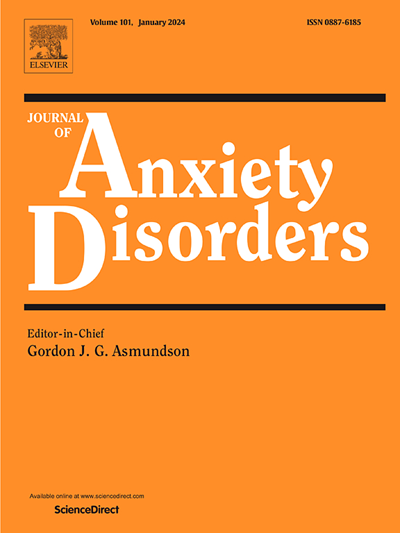蜘蛛恐惧症的反眼跳表现及其与多模态相关恐惧的关系。
IF 4.5
2区 医学
Q1 PSYCHIATRY
引用次数: 0
摘要
摘要:本研究探讨了蜘蛛恐惧症(SP)和健康对照(HC)个体通过情绪反扫视任务的抑制控制。注意控制理论(ACT)提示焦虑相关的抑制控制缺陷,但对焦虑障碍患者的抗扫视表现的研究很少。本研究填补了这一研究空白,并进一步探讨了对蜘蛛恐惧的多模态测量与抗眼跳表现之间的推定关联。方法:76名被试(41名SP, 35名HC)使用蜘蛛和花的示意图完成反扫视任务。我们分别测量了反扫视延迟和错误率。在自由观看任务中,我们获得了对蜘蛛图片的心理生理和主观恐惧反应。对蜘蛛的自评恐惧通过问卷进行评估,回避行为通过行为回避测试进行评估。结果:与ACT预测相反,与刺激类别无关,SP表现出更短的抗眼跳潜伏期,表明更有效的抑制控制,而与HC相比,抗眼跳错误率没有差异。与先前的研究结果一致,SP参与者表现出较高的心理生理反应、恐惧等级和回避行为。抑制控制表现和这些恐惧测量之间没有明显的联系。讨论:我们的研究结果表明,与HC相比,SP的抑制控制效率更高,这与ACT预测的损伤和亚临床焦虑中观察到的损伤形成了对比。这些发现可能表明焦虑障碍的代偿性适应,使注意力快速避免威胁。我们的研究结果还表明,抑制性控制可能在不同的焦虑障碍中受到不同的影响,这取决于他们对恐惧或焦虑的倾向,同时也独立于不同的恐惧和焦虑的测量。本文章由计算机程序翻译,如有差异,请以英文原文为准。
Antisaccade performance in spider phobia and its association with multimodal correlates of fear
Introduction
This study explored inhibitory control in spider phobic (SP) and healthy control (HC) individuals using an emotional antisaccade task. Attentional control theory (ACT) suggests anxiety related deficits in inhibitory control, yet studies on antisaccade performance in anxiety disordered patients are sparse. This study addressed this research gap and additionally aimed to explore putative associations of antisaccade performance with multimodal measures of fear of spiders.
Methods
A sample of 76 participants (41 SP, 35 HC) completed an antisaccade task, employing schematic pictures of spiders and flowers. We measured antisaccade latencies and error rates, respectively. In a free-viewing task, we obtained psychophysiological and subjective fear responses to pictures of spiders. Self-rated fear of spiders was assessed via questionnaires and avoidance behavior was assessed in a behavioral avoidance test.
Results
Contrary to ACT predictions, SP exhibited shorter antisaccade latencies irrespective of stimulus category, indexing more efficient inhibitory control, while showing no differences in antisaccade error rates when compared to HC. Consistent with prior findings, SP participants showed elevated psychophysiological responding, fear ratings and avoidance behavior. No significant associations emerged between inhibitory control performance and these measures of fear.
Discussion
Our findings suggest enhanced inhibitory control efficiency in SP compared to HC, contrasting impairments predicted by ACT and observed in subclinical anxiety. These findings may indicate a compensatory adaptation in anxiety disorders, enabling rapid attentional avoidance of threat. Our results also imply that inhibitory control may be differentially affected across various anxiety disorders, depending on their predisposition towards fear or anxiety, while also being independent from diverse measures of fear and anxiety.
求助全文
通过发布文献求助,成功后即可免费获取论文全文。
去求助
来源期刊

Journal of Anxiety Disorders
Multiple-
CiteScore
16.60
自引率
2.90%
发文量
95
期刊介绍:
The Journal of Anxiety Disorders is an interdisciplinary journal that publishes research papers on all aspects of anxiety disorders for individuals of all age groups, including children, adolescents, adults, and the elderly. Manuscripts that focus on disorders previously classified as anxiety disorders such as obsessive-compulsive disorder and posttraumatic stress disorder, as well as the new category of illness anxiety disorder, are also within the scope of the journal. The research areas of focus include traditional, behavioral, cognitive, and biological assessment; diagnosis and classification; psychosocial and psychopharmacological treatment; genetics; epidemiology; and prevention. The journal welcomes theoretical and review articles that significantly contribute to current knowledge in the field. It is abstracted and indexed in various databases such as Elsevier, BIOBASE, PubMed/Medline, PsycINFO, BIOSIS Citation Index, BRS Data, Current Contents - Social & Behavioral Sciences, Pascal Francis, Scopus, and Google Scholar.
 求助内容:
求助内容: 应助结果提醒方式:
应助结果提醒方式:


